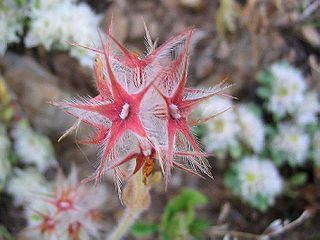
Mindat.org is a non-commercial interactive online database covering minerals based in the United States. Originally created by Jolyon Ralph as a private project in 1993, it was launched as a community-editable website in October 2000. As of 2023 it is operated by the Hudson Institute of Mineralogy.

Mason bee is a name now commonly used for species of bees in the genus Osmia, of the family Megachilidae. Mason bees are named for their habit of using mud or other "masonry" products in constructing their nests, which are made in naturally occurring gaps such as between cracks in stones or other small dark cavities. When available, some species preferentially use hollow stems or holes in wood made by wood-boring insects.

Zapodidae, the jumping mice, is a family of mouse-like rodents in North America and China.

Latimeriidae is the only extant family of coelacanths, an ancient lineage of lobe-finned fish. It contains two extant species in the genus Latimeria, found in deep waters off the coasts of southern Africa and east-central Indonesia. In addition, several fossil genera are known from the Mesozoic of Europe, the Middle East, and the southeastern United States, dating back to the Triassic.

Epihippus is an extinct genus of the modern horse family Equidae that lived in the Eocene, from 46 to 38 million years ago.
Kabanda is a village in the Bassar Prefecture in the Kara Region of north-western Togo. The village is located west the towns of Afoou and Kalia and east of Sante Bas.
Kankoura, Bigel Kankoura, or Biguel Kankoura is a village in the Tiankoura Department of Bougouriba Province in south-western Burkina Faso. The village has a population of 409.
Semecarpus kraemeri, or Chuuk poisontree, is a species of plant in the family Anacardiaceae. It is endemic to the island of Chuuk within the Federated States of Micronesia. A fellow endemic, the great Truk white-eye is thought to depend on this plant for survival.
Alabato is a village in the Oio Region of northern Guinea-Bissau. Alabato has a wet, tropical savannah climate.
Darah District or formerly known as Darah Hazara is a District of Panjshir Province in Afghanistan. The inhabitants are predominantly Sunni Hazaras. The population in 2019 was estimated to be 15,407.
Ab Garm is a village in Hanza Rural District, Hanza District, Rabor County, Kerman Province, Iran. At the 2006 census, its population was 37, in 6 families. It is a populated place - a city, town, village, or other agglomeration of buildings where people live and work.

Sphenorhynchia plicatella is an extinct species of brachiopods belonging to the family Prionorhynchiidae.

Osmia subfasciata is a species of bee in the family Megachilidae. It is found in Central America and North America.
The borate fluorides or fluoroborates are compounds containing borate or complex borate ions along with fluoride ions that form salts with cations such as metals. They are in the broader category of mixed anion compounds. They are not to be confused with tetrafluoroborates (BF4) or the fluorooxoborates which have fluorine bonded to boron.

The sulfate carbonates are a compound carbonates, or mixed anion compounds that contain sulfate and carbonate ions. Sulfate carbonate minerals are in the 7.DG and 5.BF Nickel-Strunz groupings.

Trifolium stellatum, the star clover, is a species of annual herb in the family Fabaceae. They have a self-supporting growth form and compound, broad leaves. Flowers are visited by mason bees, Anthocopa, Osmia aurulenta, and Anthophora. Individuals can grow to 0.11 m.

Fistuliporidae is an extinct family of bryozoans within the order Cystoporida. Members of this family have lived from the early Ordovician to the late Triassic period.

Nidophis is an extinct genus of Madtsoiid snake that inhabited on Hațeg island in what is now Romania. It was a small snake measuring 1 metre (3.3 ft) long.
Osmia adae is a species of bees within the genus Osmia, also known as mason bees, in the Megachilidae family.
Osmia lanei is a species of bee belonging to the genus Osmia and the family Megachilidae. They are native to northern California. Like all mason bees, it is solitary and does not work in massive hives. The species was first described in 1939 by Grace A. Sandhouse.










